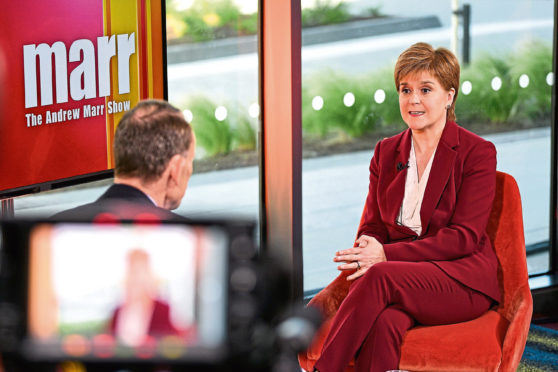Now is perhaps not the best time to encourage further constitutional upheaval in the UK, with the Brexit process continuing to divide the nation and the Parliament, as well as undermine our democracy and even the role of the monarchy.
On top of this, the dispute over the Irish backstop has threatened the Northern Ireland peace deal, created new levels of fear in the province and, some believe, made the prospect of reunification increasingly feasible.
All in all, this country needs less, not more, domestic instability, but this week saw the Scottish nationalists’ autumn conference and the separatists would never miss an opportunity to kick Britain when she is down.
On the opening day of the party gathering in Aberdeen on Sunday, Nicola Sturgeon threw down the gauntlet, telling the BBC’s Andrew Marr she would, within weeks, request powers to repeat the 2014 referendum.
Prime Minister Boris Johnson will refuse permission, but that will only strengthen the nationalists’ perceived grievances and embolden their cause.
They were triumphalist at the beginning of the week, as an eve-of-conference poll by Panelbase put support for separation at 50%.
The survey also found that 39% of Sots were planning to vote for the SNP in a general election, which would give the party 48 seats, up from 35 in the 2017 election, according to psephologist John Curtice.
Leading unionists, including some of those who spearheaded the victorious Better Together campaign five years ago, are understandably gloomy.
But, for many reasons, there is no need to despair; the nationalists’ road ahead is strewn with obstacles, and most are of their own making.
Sturgeon herself spelt out a particularly big one on Sunday, when she admitted to Marr that a hard border with England was a possibility if an independent Scotland rejoined the European Union following Britain’s exit.
Having repeatedly ruled out such a scenario in the past, she conceded that she would have to “see how things play out and what the final relationship between the UK and EU will be”.
Naturally, she insisted such an outcome – economically disastrous considering 60% of Scotland’s trade is with the UK – would not be her choice. “I don’t want borders,” she said, as if the consequences of secession were someone else’s responsibility.
Pamela Nash, chief executive of Scotland in Union, said a hard border, governed by the EU, would end 300 years of free movement.
“We know it would be catastrophic for our economy, as we trade nearly £50 billion with the rest of the UK,” she said. “It would put livelihoods at risk as over half a million jobs in Scotland are supported by the rest of the UK.”
The nationalists lost the last referendum on the back of a very weak economic strategy for going it alone, and despite the protestations of SNP finance minister Derek Mackay, they have yet to improve their case.
Scotland had a deficit last year more than six times larger than the UK’s, according to official figures. This country, after nearly 10 years of nationalist rule, spent £12.6 billion more than it raised in taxes in 2018, a deficit that is 7% of GDP. England, in the same period, had a deficit of just 1.1% of GDP.
But making a coherent fiscal argument for separation may turn out to be the least of the nationalists’ problems by next year, which is when Sturgeon said she wants the referendum rerun to take place.
Her predecessor, Alex Salmond, is facing two charges of attempted rape and nine counts of sexual assault, with his trial due to come to court in 2020.
Sturgeon will also be under scrutiny, as a Scottish parliamentary inquiry looks into allegations that her office mishandled the Salmond claims.
While their current and former leaders are trying to clear their names, the party would be advised to keep its head down. But by then, the leadership might have lost any grip on rebel members, who disrupted conference this week with their call for a unilateral declaration of independence should the nationalists do well in a general election.
And senior nationalists are apparently talking about the vultures circling, as ambitious MPs such as Ian Blackford and Joanna Cherry scent a job vacancy.
Then, of course, there is the unpredictability of the government at Westminster. Boris Johnson’s arrival in Number 10 no doubt helped push the SNP to its present poll lead. His quick removal – perfectly plausible – could have the opposite effect.
Is it too fanciful to predict that by this time next year, as Scotland prepares for its own elections in 2021, the dust will have settled on Brexit, the Johnson premiership will be but an amusing historical footnote, and Scottish voters will have once again come to their senses?
